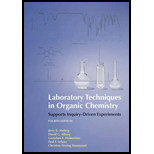
Interpretation:
The reason for the better efficiency of GC than fractional distillation should be stated.
Concept introduction:
Gas chromatography is efficiently used for the compounds that have high vapor pressures which allow them to pass through a GC column.
A gas chromatography does not identify compounds if unknown samples are loaded into the column. GC is one of type of partition chromatography, where the sample that has to be analyzed gets adsorbed on the stationary phase.
The stationary phase is formed by high boiling nonvolatile liquid, usually a
The components of gas-liquid chromatography are as follows:
- High-pressure pure carrier gas source
- Flow controller
- Heated injection port
- Column and column oven
- Detector
- Recording device or data station
Explanation of Solution
The separation of mixtures during gas chromatography is due to the interaction of compounds present in the mixture in different ways with the liquid stationary phase.
A GC column is composed of thousands of theoretical plates which result in a huge surface area on which the gas and liquid phases can interact. The partition of a substance between the liquid and gas phases is based on its relative affinity to the liquid phase and its vapor pressure. The higher is the vapor pressure, the greater is its tendency to go from the liquid stationary phase into the mobile gas phase.
As the substances rise up in the GC column, thousands of liquid-gas equilibria take place. A low boiling compound remains in gas phase for longer time than a high boiling compound.
Generally, compounds that have low boiling points have high vapor pressures. So they rise through a GC column faster than compounds that have high boiling points.
In the case of fractional distillation, the number of theoretical plates is less than 10 so the surface is in comparison to GC is less for interaction between the gas and liquid phases. This leads to poor separation of compounds.
Want to see more full solutions like this?
Chapter 20 Solutions
Laboratory Techniques in Organic Chemistry
- Draw the Fischer projection from the skeletal structure shown below. HO OH OH OH OH H Q Drawing Atoms, Bonds and Rings Charges I ☐ T HO H H OH HO I CH2OH H OH Drag H OH -CH2OH CHO -COOH Undo Reset Remove Donearrow_forwardplease provide the structure for this problem, thank youarrow_forwardpresented by Morallen Lig Intermine the hand product for the given mution by adding atoms, bonds, nonhonding diarion panda скуль Step 3: Comp the draw the product Step 2: Agama workup Compithe 429 ملولةarrow_forward
- Reaction A 0,0arrow_forwardpresented by Morillon Leaning Predict the organic product for the min кусур HSC Adithane carved arnown to come than that to the condon slchroruis in acid in in aquishri with ноюarrow_forward6.15PM Sun Mar 30 K Draw the major product of this reaction. Include any relevant stereochemistry. Ignore inorganic byproducts. Problem 1 of O H [PhзPCH2CH3]*C|¯ NaH Drawing > Q Atoms, Bonds and Draw or tap a nearrow_forward
- 8:17 PM Sun Mar 30 Draw the major product of this reaction. Ignore inorganic byproducts. HSCH2CH2CH2SH, BF3 Probler Drawing Ato Bonds Clarrow_forwardpresented by Mr L How the coprion. (Il Done in no wraction, dew the starting redential) доarrow_forward8:16 PM Sun Mar 30 K Draw the major product of this reaction. Ignore inorganic byproducts. Proble 1. CH3MgBr 2. H3O+ F Drawingarrow_forward
- о но оarrow_forwardName the major organic product of the following action of 4-chloro-4-methyl-1-pentanol in neutral pollution 10+ Now the product. The product has a molecular formula f b. In a singly hain, the starting, material again converts into a secule with the molecular kormula CIO. but with comply Draw the major organic structure inhalationarrow_forwardMacmillan Learning Alcohols can be oxidized by chromic acid derivatives. One such reagent is pyridinium chlorochromate, (C,H,NH*)(CICTO3), commonly known as PCC. Draw the proposed (neutral) intermediate and the organic product in the oxidation of 1-butanol by PCC when carried out in an anhydrous solvent such as CH₂C₁₂. PCC Intermediate OH CH2Cl2 Draw the intermediate. Select Draw Templates More с H Cr о Product Draw the product. Erase Select Draw Templates More H о Erasearrow_forward
 Macroscale and Microscale Organic ExperimentsChemistryISBN:9781305577190Author:Kenneth L. Williamson, Katherine M. MastersPublisher:Brooks Cole
Macroscale and Microscale Organic ExperimentsChemistryISBN:9781305577190Author:Kenneth L. Williamson, Katherine M. MastersPublisher:Brooks Cole
